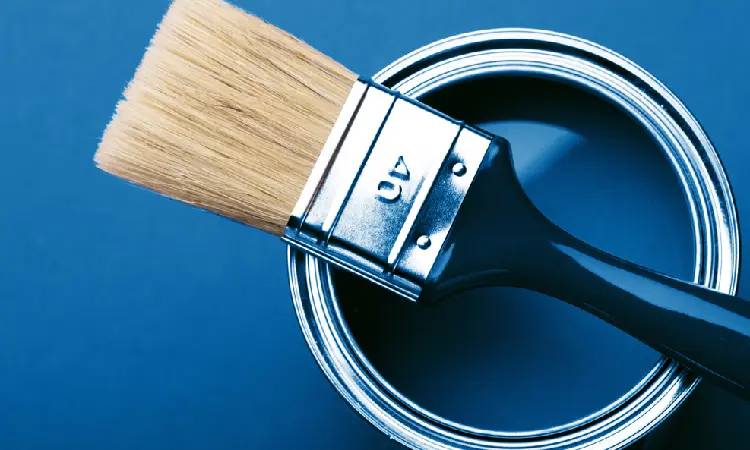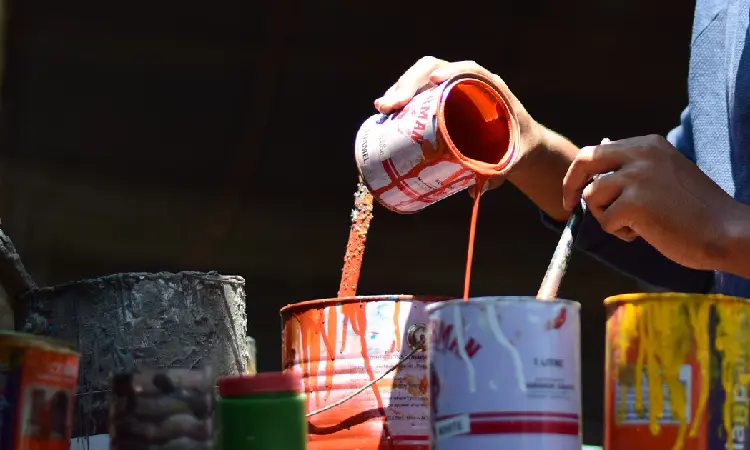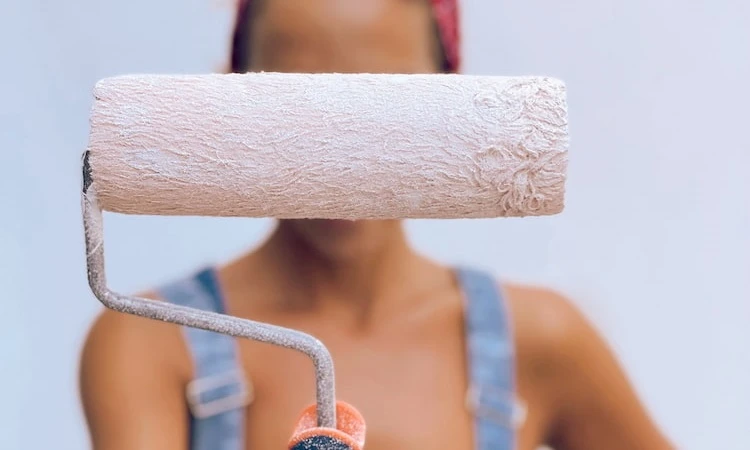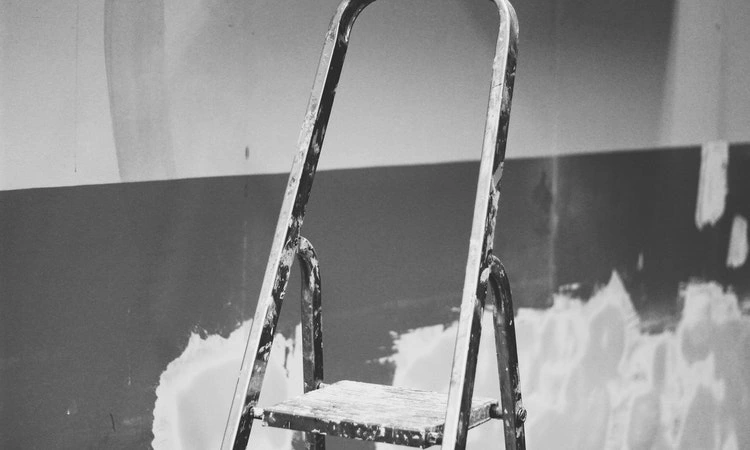Did you know that there are different finishes for paint? Maybe you purchased a flat paint, but you realized you wanted a shiny finish after it dried.
Suppose you know there is a difference between finishes, but you have flat paint that you want to use up. Can you make the paint glossy?
Surprisingly, you can make a flat paint glossy. With varnishes, mediums, and more, you can change the sheen of any paint. You can make your wall look glossier. Or you can make the dresser you painted to have a more glossy finish.
The acrylic paint on your canvas can also become glossier with the help of a medium.
First, you will need to learn what makes paint glossy or flat. There is more to the paint’s finish than just the term used to describe it.
In this article, I will explain what makes paint glossy. I will also tell you how you can make any paint glossy.

What Makes Paint Glossy or Flat?
All paints are made up of solvents, binders, pigments, and additives.
The concentration of pigments relative to their binder separates gloss paints from flat paints. But what are pigments and binders?
Pigments are the material that gives the paint color. The pigments can be made of organic or synthetically made compounds.
In contrast, the binder is the glue that holds the paint together. It allows the paint to adhere to various surfaces.
Pigment Volume Concentration
Binders reflect light, while pigments absorb light. These properties are how manufacturers can make paints with different finishes.
The finish of a product is determined by its pigment volume concentration (PVC). In other words, it is the ratio of pigment to other ingredients in the paint.
The higher the PVC, the flatter the paint. In contrast, the lower the PVC, the shinier the finish. Products labeled flat typically have a PVC of 40-80%.
Gloss paints have a PVC of 0-15%. What does this mean in simpler terms? Glossy paints have fewer pigments compared to flat paints.
Since pigments absorb light, you need paint with fewer pigments if you want a shiny finish. On the other hand, binders reflect light.
So if you want a flat finish, you need paint with a higher pigment-to-binder ratio.
Can You Paint With Gloss Paint Over a Matte Finish?
Of course, you can paint over matte paint with glossy paint. You will have to make sure the paints are both oil or water-based. You cannot paint over oil-based paint with water-based paint.
Some people choose to use matte paint for the first coat to save money. After all, matte paints are cheaper than gloss paints. However, the gloss paint may not be as shiny when covering matte paint.
You can choose this route if you are on a tight budget. I am just going to advise you to be cautious. Paint requires a second coat to achieve its full color and shine potential.
The gloss paint may not be as shiny as you would like because the first coat does not have the same finish.
If you are going to change the color of the paint, you should prime the surface and then paint it.
You can cover matte paint with a different shade of gloss paint. However, you will often be left with a color that is a mix of the two shades of color.
No matter what finish the paint is, if you want to change the color of the wall, you must apply a primer.
The primer will ensure the old color does not bleed through. It will also prepare the surface for the new paint.
Is There a Way to Make Flat A.K.A. Matte Paint Glossy?

It is possible to make matte paint glossy. Maybe you were hoping your finished product would be shinier. Or maybe you had matte paint that you wanted to use up, but now you want the finished project to look shinier.
If you have not applied the paint, you can mix a medium into the flat paint to make it glossy.
This option works best for small projects, such as acrylic painting on canvases. You will have to mix the medium into the paint in small batches. Start with a small bit of paint and the medium.
Thoroughly mix the two until there are no lumps present. You should test your ratio of paint to medium every time you add more of the medium.
You can continue adding the medium until the paint reaches your desired level of shine.
Keep in mind that you may have to let the paint dry to determine its level of shine. You can still make the paint glossy after it has already dried.
You can paint over matte paint with a clear gloss varnish. This is the best option for large projects such as walls and furniture.
Once the matte paint is fully dry, you can apply the clear varnish. The varnish will add shine and durability to your painting project.
How to Make Matte Paint Glossy
There are a few different ways you can make paint glossy. Most paints can be given a shinier finish using a medium or varnish.
Your options will vary depending on the type of paint you use. Below, I will describe how you can make acrylic and latex paints glossy.
1. Making Flat Acrylic Paint Glossy
You can use a medium or a varnish to make acrylic paint glossy. You may need to use both to achieve the sheen you want in some cases.
A medium can be added to your paint before painting. Or you can apply it after the paint has dried. In contrast, a varnish can only be used as a top coat on the paint.
A. Acrylic Gloss Medium
An acrylic gloss medium can be mixed into your paint. Gloss mediums are great when working on canvases or other small projects.
You will want to start with a small amount of acrylic medium. The medium and the paint should be mixed until they are cohesive.
You can and should test the mixture on a small part of your project. You should let the test patch dry to determine if it is the shine you want.
If not, you can continue adding the medium to the paint. Thankfully, acrylic paint dries relatively quickly.
But what do you do when working on a large project? It can be difficult to remember the exact ratio of medium to paint. Luckily for you, another option is to make the paint look glossy.
B. Acrylic Gloss Varnish
Once the paint has dried onto the wall or furniture, you can apply an acrylic gloss medium or a varnish.
If you are working on a large canvas, be cautious that some varnishes may not be ideal for the material. You should read the label to determine if you can use the varnish for your project.
Varnishes are often used for finishing wood projects. They add a level of shine and still show off the wood’s grain and natural beauty. Varnishes seal off and protect the underlying surface.
Therefore, they should only be used once the paint is fully dried.
You can use resin or Liquitex’s acrylic varnish. It is possible to mix a varnish into acrylic paint, but I do not recommend this.
It is easier to mix a gloss medium into acrylic paint compared to mixing a varnish into the paint.
If you still want to mix the varnish into the paint, make sure you use a varnish designed for acrylic paint.
Many varnishes contain oil in them, which can make them difficult to mix with acrylic paint. However, they do make varnishes specifically for use with acrylic paints.
If the paint and varnish do not mix well, you can apply the varnish onto the dry coat of paint. Now, do you see why I do not recommend mixing varnishes with acrylic paint?
It is a tedious process, and you can waste paint when you find out they do not mix well.
Remember that you may need to use the medium with the varnish for some projects.
This is acceptable and will not cause any harm as long as both products are designed for acrylic paints.
2. Making Flat Latex Paint Glossy
You can purchase a glossy clear coat to apply over flat latex paint. You will have to make sure the clear coat is the same type of paint.
A water-based clear coat can not be used on oil-based paints and vice versa.
Polycrylic varnish is great for most surfaces. It is a water-based finish; therefore, it will work great with latex paints. You can find it available in gloss, satin, and other finishes.
Additionally, you can mix a glazing compound or varnish with flat paint.
This process has to be performed in small batches. Below are the steps on how to mix in a glazing compound or varnish:
- You start by pouring the glazing compound or varnish equal to about 10% of the volume of the paint into a large container.
- Then stir in the paint.
- Test the paint in a small inconspicuous area to see if you have achieved your desired sheen.
- Continue to add small amounts of the glazing compound or varnish until you achieve your desired results.
You will have to be careful when performing this process. It is easy to overdilute the paint. You should test the paint every time you add more glazing compounds.
By testing the paint, you ensure the paint is not too diluted, and you can check to see if the paint has achieved the glossy finish you want.
Another option to make the paint glossy is to paint over the matte paint with a glossier sheen of the paint.
You have to make sure you are using the same shade and brand of paint when you do this. Please keep in mind there is a slight chance the paint will not dry as glossy compared to just using the glossy paint.
Most paints recommend you apply two coats of paint. The second coat of paint helps achieve full coverage. It also helps solidify the sheen of the paint.
When you paint over matte paint with glossy paint, the two sheens essentially mix together and can form a sheen somewhere between the two.
What About Polyurethane Gloss Varnish?
You can use polyurethane as a top coat on latex paints. Do not mix it with the paint. Polyurethane is a harsh compound.
It can destroy the paint and make it unable to adhere to a surface. Some manufacturers produce water-based polyurethane.
You may be tempted to mix it with your water-based paint, but I caution you against that.
Save yourself some time and money by applying the polyurethane as a top coat instead of mixing it into the paint.
Pro-tip for Mixing Paint and Glossy Additives
You should keep a stir stick nearby whether you are mixing a glazing compound, lacquer, varnish, medium, or any other glossy additive into the paint.
You will want to stir the mixture before pouring more into your paint tray.
Why is this important? Paint naturally separates, and now you are adding an additive to it. By stirring the mixture, you keep the sheen consistent throughout your project.
Can You Mix a Flat Paint with a Glossy Paint?
You can mix flat or matte paint with glossy paint. However, the end result will not be as glossy as you hope. When you mix flat paint with glossy paint, you often end up with a sheen resembling satin.
Most people assume the glossy paint will make up for the binders lacking in the flat paint.
But, they fail to consider how the pigments in the flat paint will make up for the pigments lacking in the gloss paint. These two mechanisms cause the paint to have a more satin finish.
Yes, mixing a flat and glossy paint will create a shinier finish, but it may not be the finish you ultimately want. I just want you to be realistic about the expectations.
If you want to mix two paints, make sure they are the same brand and the same color.
Some brands carry similar colors, but they can have different pigmentations. If you mix two different paint colors, you will alter the color.
Also, keep in mind that different brands use different chemicals and pigments in their paint.
You do not want to mix two paints that will have a chemical reaction with each other. Nor do you want to mix oil-based paint with water-based paint.
Basically, there are a lot of different variables that go into mixing paint. Unless you have been trained to mix paints and you have been doing it for years, I would not mix two paints.
Paint is expensive, and you do not want to waste money because the paints did not mix the way you originally intended.
FAQS: Making Paint Glossy
This article has explained and described what makes paint glossy or flat. I have also discussed how you can make acrylic and latex paint glossy.
Now, I will try to answer a few other questions I have been asked about making paint glossy.
1. How to Make Chalk Paint Glossy?
Chalk paint is known for providing a sleek matte finish to walls and furniture. Many people specifically choose chalk paint for its matte finish.
But maybe you want to make your chalk paint glossy. Well, I can help with that dilemma.
You can apply a layer of clear lacquer or a similar product to the dried chalk paint.
You can also use a wax designed for chalk paint. The wax will add shine and an extra layer of protection to the paint.
Some people use a latex glossy clear coat to give their chalk paint a glossy finish. You may want to avoid this option if you are painting furniture.
Some clear latex coats can give the furniture a tacky feeling. Wax will often provide a smoother feeling and finish.
2. Can You Mix Flat and Semi-gloss Paint?
You can mix paint with different sheens. You just have to ensure the paints have the same solvent and binders.
The final sheen will often be somewhere in between the two sheen. You should not expect the paint to be eggshell or satin.
The resulting finish will not be the perfect or normal sheen you buy from the store. You can mix the two sheens as an experiment or when you are in a pinch.
However, I recommend choosing a higher gloss paint or using a high gloss clear coat instead of mixing two paints with different sheens.
3. How to Make Paint Shiny on Wood?
Polyurethane is the number one recommended top coat for wood projects.
It will add a layer of shininess and display the beauty of the wood’s natural grains. You should know that no polyurethane is clear.
Even the ones advertised as a clear coat do not dry clear. Polyurethane can have a slightly blue appearance when applied, and it will often dry with a semi-milky appearance. However, it will provide the shine you are looking for.
You can also use a high gloss clear enamel paint. The clear enamel paints typically dry more clearly, but they may not show the beauty of the wood as much.
Either option will make the paint shiny. It is just up to your personal preference which option you choose.
4. How to Make Acrylic Paint Glossy Without Varnish?
Acrylic paint already has a natural shine to it. But maybe you want it to be shinier. When painting large surfaces, you can use an acrylic medium to make the paint glossy.
Acrylic mediums can be added to the paint before painting. Or you can apply it as a top coat.
Art-grade resins are designed for small artwork projects. Some artists will use art-grade resin instead of or in conjunction with a medium.
These resins work best when they are applied to finished artwork.
Both art-grade resins and a medium will provide the same glossy effect. You will just have to choose which one is best for your specific project.
You will have to wait until the paint is dry to see the glossy finish. Make sure you test the mixture in a small area to determine if it is the sheen you want.
Unfortunately, sometimes you may still need to apply a varnish to achieve your perfect finish.
Verdict
It can be complicated to make paint glossy, but it is possible. Ultimately you will have to choose whether you use an additive or a clear coat based on the kind of paint and project you are working on.
For instance, varnishes are better for wood projects because they bring out wood’s natural beauty. You may have to use some trial and error during the process.
It can be difficult to find the perfect sheen when you are the one making it. I wish you luck, and I hope this article helps you.





